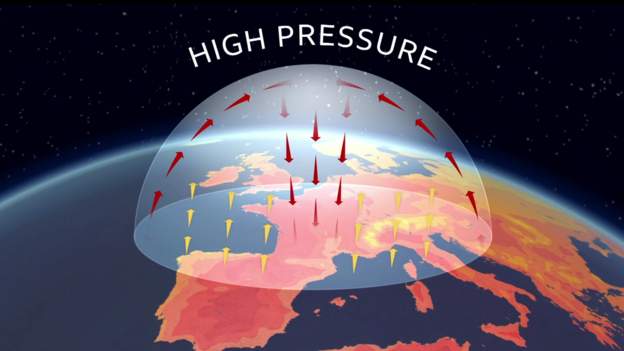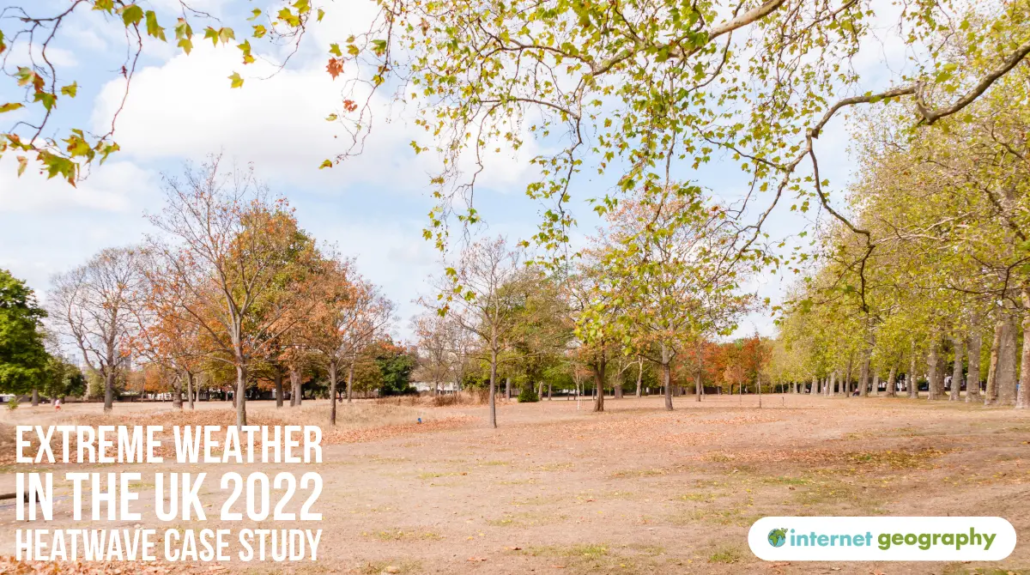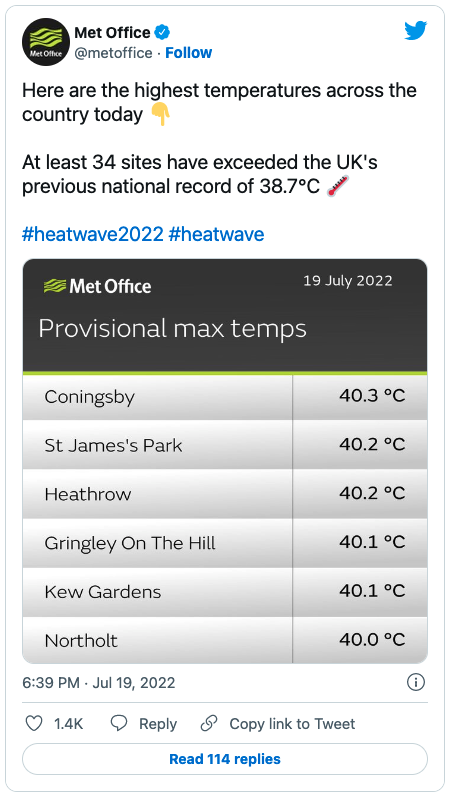Extreme Weather in the UK 2022 Heatwave Case Study
Introduction
In July 2022, the UK experienced its most extreme heatwave on record. For the first time in UK history, temperatures exceeded 40°C, with a new record of 40.3°C recorded in Coningsby, Lincolnshire. According to the Met Office, over 34 locations across the UK broke the previous national record of 38.7°C, set in 2019. Even Scotland experienced record-breaking heat, with a high of 34.8°C.
What caused the heatwave in July 2022?
The July 2022 heatwave was driven by a powerful area of high pressure, known as the Azores High, which expanded unusually far north. This blocked cooler Atlantic air, allowing intense heat from southern Europe and North Africa to move across the UK.
Additionally, a heat dome — a large mass of hot air trapped under high pressure — developed over Western Europe. This phenomenon intensified the heat, leading to record-breaking temperatures across the continent and the UK.

A heat dome – Source BBC.
How is the heat wave linked to climate change?
According to the UK Met Office, climate change made this event at least 10 times more likely. Human activity, such as burning fossil fuels, has increased the amount of greenhouse gases in the atmosphere, thereby enhancing the natural greenhouse effect and contributing to a rise in global temperatures.
While heatwaves are part of natural weather patterns, they are now:
- More frequent
- More intense
- Lasting longer
NASA data shows a steady rise in global average temperatures since 1880, with 2022 among the hottest years on record.
As heatwaves worldwide hit record temperatures, this NASA graphic reveals how the world has warmed since 1880.
What were the impacts of the 2022 heatwave?
The heatwave had severe impacts across the UK, affecting health, infrastructure, and the environment:
Human Impacts
- Five people died in separate water-related incidents while trying to cool off.
- Hospitals cancelled surgeries due to overheated operating theatres.
- Vulnerable groups (elderly, very young, and those with health conditions) were especially at risk.
Fires and Emergencies
- On 19th July, London Fire Brigade declared a major incident – their busiest day since World War II.
- Over 2,600 calls were made, with more than a dozen fires burning across the capital.
- 41 properties in London were damaged by fire, including homes in Wennington, where 100 firefighters battled a blaze.
- Major incidents were also declared in South Yorkshire, Hertfordshire, and Leicestershire, with homes destroyed in Barnsley.
Transport Disruption
- Train travel was down by 40% due to heat-related delays and cancellations.
- The East Coast Main Line and services between Manchester and Sheffield were suspended.
- Overhead cables melted and caused fires in places like Harrow, London.
- Luton Airport suspended flights after the runway surface buckled.
- The RAF halted operations at Brize Norton due to runway damage.
Power and Utilities
- Almost 15,000 properties in Yorkshire, Lincolnshire, and the North East lost electricity due to overheating equipment.
- Rivers and waterfalls such as Aysgarth Falls in the Yorkshire Dales ran dry due to heat and low rainfall.
What were the responses to the 2022 heatwave?
National Warnings
The Met Office issued its first-ever Red Warning for Extreme Heat, advising the public of serious risks to life and infrastructure.
Infrastructure Measures
- Gritters were deployed to prevent roads from melting.
- Hammersmith Bridge in London was wrapped in silver foil to reflect heat and protect structural integrity.
- Rail speed restrictions were put in place to reduce the risk of track buckling.
- The East Coast Main Line was closed for safety.
Emergency Services
- Fire brigades across the country declared major incidents and received reinforcements.
- Local councils provided cooling advice and emergency support to vulnerable residents.


